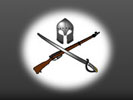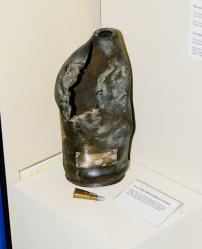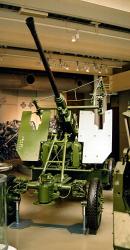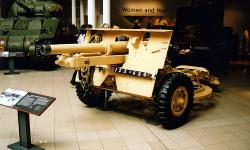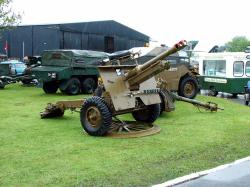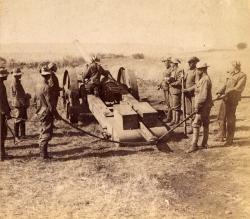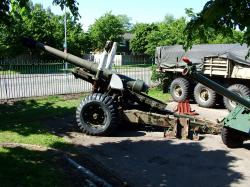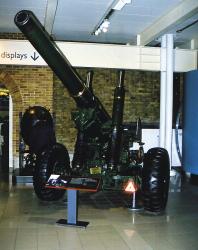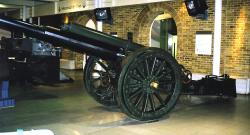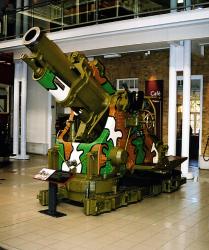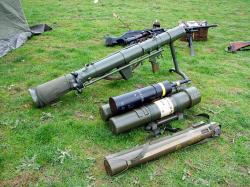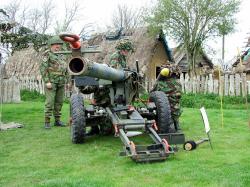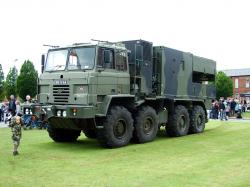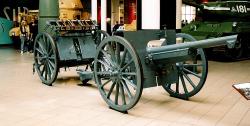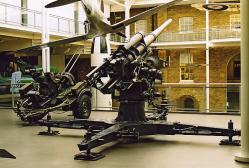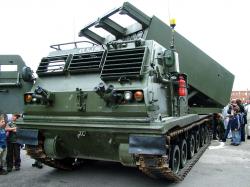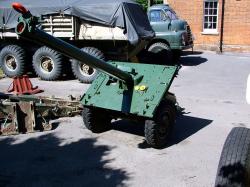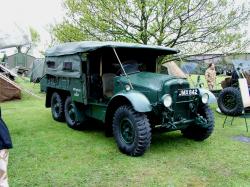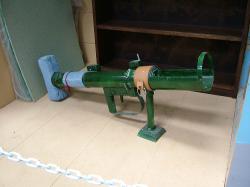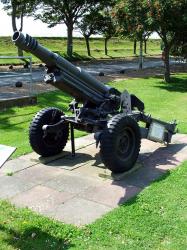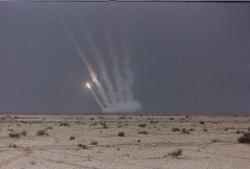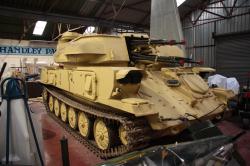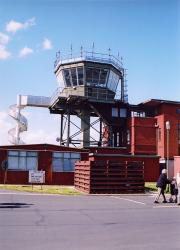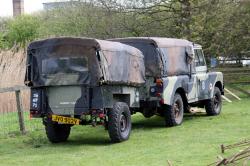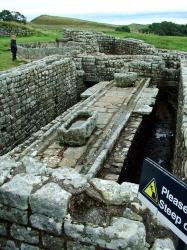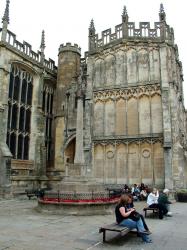Translate this Page
Recent images :
- International Harvester M5 halftrack
- Dassault Mystère Mk IVa number 146
- Ark Royal, Anti-ship missile defence gun.
- RAF Series 2 Land Rover
- Lightweight, air portable Land Rover
- Daimler Ferret Mk 1/2 Armoured Car
- RAF Mountain Rescue Series 3 Land Rover
- French Bronze 6 pounder cannon
- Farsley South African War Memorial
- Farsley War memorial
Images of Artillery
Click on the entry for a larger image and details, or click to go back to the previous index
A 94 pound shell from one of the Boer 'Long Tom' Creusot artillery pieces fired into the town of Ladysmith during it's seige. It presumably failed to explode. Also shown are a couple of rounds of Boer ammunition. The Manchesters Regiment were besiege...
The Museum of Manchester's Regiment, Ashton-under-Lyne, UK. March 2004
The 40mm L/60 automatic anti-aircraft gun was designed in Sweden by Bofors in 1928. It became so successful it was simply known as a 'Bofors gun' and in various guises has been used by many armed forces up to the present. This particular example date...
Imperial War Museum, London, England. October 2003.
This British field gun was introduced in 1904 and was primarily used during World War 1. It could fire an 8.4kg shell up to 5965 metres and had a calibre of 84mm.
Imperial War Museum, London, England. October 2003.
The 25lbr Mk II QF gun was the standard British divisional field gun from the 1940's up to the late 1960's. It could be used in both the close support and anti-tank roles. The large wheel-like disk mounted horizontally under the body of the carriage ...
Imperial War Museum, London, England. October 2003.
These images show a 25 pounder gun with it's tractor, the Morris C8 Field Artillery Tractor (FAT) known as the Quad in WW2 colours. The Morris Quad was based on a pre-war 4x4 and continued inservice along with the 25lbr through the Second World War a...
The Wheels and Wings 2006 event, Yorkshire Air Museum, York, UK. May 2006.
A view of one of the huge, converted Naval pieces used as artillery in the Anglo-Boer war. It is from an Underwood and Underwood stereoview and is entitled "Sighting one of the 4.7 Naval Guns on the Boer Position at Schwartzkop, S.A."
South Africa 1900
A medium cailbre artillery piece brought into service in 1941 (this one dates from 1942) was still being used in the 1970's. It could fire a 45.4 kg shell up to a range of 14,810 metres or more than 9.2 miles.
Imperial War Museum, London, England. October 2003.
Medium artillery piece brought into service in 1904 and used extensively during World War 1 both on the Western front and in the Middle East. It's use declined during the Second World War. It had a 127mm calibre, 27.2 kg shell and a range of 12,700 m...
Imperial War Museum, London, England. October 2003.
A heavy seige howitzer from the First World War. This piece came into service in 1914 and it's incredible 290lb (131.5kg) shells would pound indirect targets up to 5.7 miles (9200metres) away. This kind of heavy artillery barrage became iconic of bat...
Imperial War Museum, London, England. October 2003.
A display of 2 light anti-armour weapons used by the British Army in the 1970's and 80's.
The larger of the two is the Carl-Gustav 84mm recoilless rifle shown sitting on it's bipod mount. Also shown are examples of it's armour-piercing rounds.
...
History at Murton - Murton Park, York, England. April 2008
An artillery piece looked after by members of the 20th Century Revisited group. It was a prominent infantry fire support weapon from the 1960's.
It was a 120mm recoilless rifle and had a range of between 800 and 1000 yards. It fired a HESH round w...
History at Murton - Murton Park, York, England. April 2008
A re-creation of a crew of British Army personnel working a Mobat recoilless anti-tank weapon of the 1970's.
Crew'ed by members of the 20th Century Revisited group.
History at Murton - Murton Park, York, England. April 2008
The Foden based Improved Medium Mobility Load Carrier mounting the Cobra radar array as used by the British Army for counter battery artillery location.
Army in Yorkshire event, Imphal Barracks, York, UK. July 2008
This important field gun was introduced in 1897 and was the standard French fieldpiece into the 1930's. It played an important role in the German defeat at Verdun in 1916 and could fire a 7.2kg shell a maximum of 6850 metres.
Imperial War Museum, London, England. October 2003.
Several of the French cannon captured by the British at the Battle of Waterloo and brought to the Tower of London by the Duke of Wellington in 1815.
Tower of London, UK. Oct 2018
The premier, multi-purpose gun of the second world war, the German 88 was respected and feared wherever it was encountered. A high muzzle velocity, good accuracy and penetrating ammunition, as well as plentiful production meant that this AA gun could...
Imperial War Museum, London, England. October 2003.
Used on all fronts throughout the second world war the 5cm pak38 was the mainstay of the German infantry's anti-tank artillery. Designed in 1940 it fired a 2.2kg armour-piercing shell up to 2,650m range.
Imperial War Museum, London, England. October 2003.
The Royal Artillery's main long range weapon system capable of launching 12 guided rockets, each delivering a 200lb warhead up to 300 miles range.
Army in Yorkshire event, Imphal Barracks, York, UK. July 2008
An untitled photograph of a troop of horse artillery from the Anglo-Boer War period. The image clearly shows the late 19th century British khaki uniform.
From an Underwood and Underwood stereoview.
South Africa 1901?
Aldershot Military Museum, Hampshire, England, May 2007
The Morris 6x4 Tractor was brought into service in the 1930's to tow heavy field guns like the 25 pounder but was not as manouverable as the later Morris Quad which replaced it. Many CDSW's were left on the beaches at Dunkirk after the evacuation and...
The Wheels and Wings 2006 event, Yorkshire Air Museum, York, UK. May 2006.
The Projector, Infantry, Anti Tank weapon or PIAT for short was used by British forces during and after World War 2, particularly by paratroopers when no other anti-tank guns were available for example at Arnhem and Pegasus Bridge. It had to be loade...
North East Aircraft Museum, Sunderland, England. October 2004.
A light artillery piece made in Italy during the 1950's to fire standard 105mm ammunution but still be either towed by a jeep or broken down and carried by mule. Used by many countries around the world including Britain and Argentina, this particular...
Royal Marines Museum, Eastney, Southsea nr Portsmouth, England. 2007
A long distance shot of an MLRS battery providing heavy artillery support during Operation Desert Storm.
Iraqi Desert, 1991
Cold-war era Soviet armoured anti-aircraft defence. Armed with 4x23mm guns, came into service in 1962 and had a crew of 4.
This particular example was captured in Iraq during operation Desert Storm.
Elvington Air Museum, March 2018
